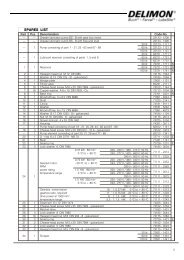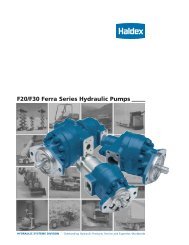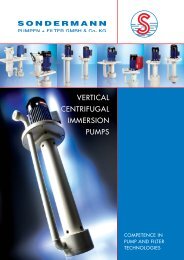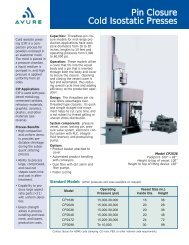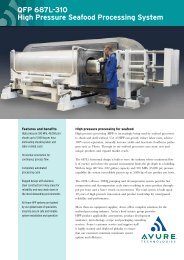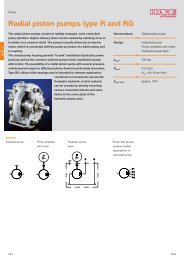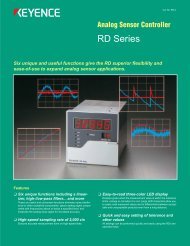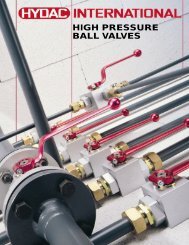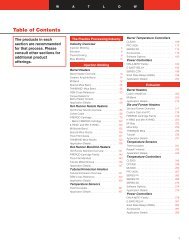Keyence CZ Series Sensor.pdf - Hasmak
Keyence CZ Series Sensor.pdf - Hasmak
Keyence CZ Series Sensor.pdf - Hasmak
Create successful ePaper yourself
Turn your PDF publications into a flip-book with our unique Google optimized e-Paper software.
NEW<br />
Three-Light Source & High Precision<br />
Featuring 3 light sources for advanced color differentiation and<br />
flexibility for installation in a variety of conditions<br />
Color-Differentiating Fiberoptic <strong>Sensor</strong><br />
<strong>CZ</strong> <strong>Series</strong>
The <strong>CZ</strong> <strong>Series</strong> boasts separate RGB light sources for<br />
high-precision detection.<br />
KEYENCE introduces two new models that brings the total to six fiber<br />
units that provide excellent color differentiation.<br />
General-purpose area type<br />
By averaging values from an area spot,<br />
the sensor can absorb inter-sample<br />
variations such as the influence of detailed<br />
patterns or scratches on the workpiece<br />
surface to deliver stable,<br />
reliable detection.<br />
10 mm<br />
0.39"<br />
to<br />
30 mm<br />
1.18"<br />
■ Dimensions<br />
Both ends are<br />
bevelled.<br />
15 mm<br />
0.59"<br />
ø0.04 to 0.14"<br />
ø0.9 to 3.5 mm<br />
ø0.24"<br />
ø6 A<br />
M6 fitting<br />
15 mm<br />
0.59"<br />
Adjust the size of the beam<br />
spot to fit the workpiece.<br />
Variable beam spot type<br />
5.2 ø5.5 A<br />
0.2" ø0.21"<br />
3<br />
A-A Lens diameter 0.39" 0.38" 0.12"<br />
cross section 2.6 10 9.6<br />
78.74"<br />
0.1"<br />
* L<br />
2000<br />
0.17" 0.37"<br />
L: Lens length *Variable length of 4.2 to 9.3 mm<br />
See pages 6 and 7 for information about applications for each type of fiber unit.<br />
Area reflective type unit<br />
■ Specifications<br />
Detection range<br />
Area width<br />
■ Specifications<br />
Detection range 10 to 30 mm 0.39" to 1.18"<br />
Beam spot diameter ø0.9 to ø3.5 mm ø0.04" to 0.14"<br />
2-ø1.3 ø0.05"<br />
Accessories: 1 mounting bracket (OP-23980), 1 M6 nut set<br />
5 to 20 mm 0.2 to 0.79"<br />
Approx. 15 mm 0.59" (for detection<br />
ranges of 10 to 15 mm 0.39 to 0.59")<br />
3 mm<br />
0.12"<br />
to<br />
15 mm<br />
0.59"<br />
■ Dimensions<br />
45.0°<br />
0.34" 8.7<br />
An area spot means stable, reliable detection capability.<br />
Detection area<br />
ø0.04 to 0.06"<br />
ø0.9 to 1.5 mm<br />
5.5<br />
0.21"<br />
15.0 0.59"<br />
■ Compatible with uneven workpiece surfaces.<br />
When the beam spot is too small, some workpiece surface shapes<br />
make the light emitted by the fiber unit impossible to receive be received by by<br />
causing it to reflect irregularly. The <strong>CZ</strong>-12 eliminates this problem,<br />
averaging light from a large area spot to enable stable detection.<br />
Small beam spot type<br />
Irregularly<br />
reflected light<br />
cannot be<br />
received.<br />
■ Compatible with variations in workpiece position.<br />
With the <strong>CZ</strong>-12’s area spot, workpieces can be detected even when<br />
there’s a slight amount of variation in the position at which they<br />
pass the spot.<br />
The area spot is<br />
compatible with<br />
variations in<br />
workpiece<br />
position.<br />
2.1 0.08"<br />
2.4<br />
0.09" 5.4<br />
0.21"<br />
Install in cramped locations.<br />
Side-view type<br />
0.13"<br />
0.41" 2-ø3.2<br />
10.4 L<br />
0.2" ø4.5 0.18"<br />
5.0 SUS303<br />
ø3.5 0.14"<br />
SUS304<br />
5.6 0.22" M3,P=0.5<br />
12.0 0.47"<br />
Lens diameter ø3.7 0.15"<br />
Area spot type<br />
<strong>CZ</strong>-12<br />
Irregularly<br />
reflected light is<br />
averaged over a<br />
large area.<br />
■ Specifications<br />
Detection range 3 to 15 mm 0.12" to 0.59"<br />
Beam spot diameter ø0.9 to ø1.5 mm ø0.04" to 0.06"<br />
11.81"<br />
300<br />
5.0<br />
0.2"<br />
ø4.5 0.18"<br />
SUS303<br />
1000<br />
39.37"<br />
Housing material: Aluminium (black anodised<br />
aluminium finish)<br />
L: 2.6 to 5.0<br />
0.1" to 0.2"
For detecting tinted transparent objects.<br />
<strong>CZ</strong>-60 Semi-transparent<br />
workpiece<br />
70 ± 20 mm<br />
2.76 ± 0.79"<br />
ø6 mm<br />
ø0.24"<br />
Reflector<br />
Recurrent reflective type unit for<br />
transparent object differentiation<br />
Digital amplifier<br />
The <strong>CZ</strong> <strong>Series</strong> of sensors can differentiate among transparent objects with only slight color<br />
differences due to its combination of the principle of recurrent reflection, which sends light through<br />
the workpiece twice and increases the light's attenuation, with a proprietary KEYENCE optical system<br />
and the sensor's high-precision detection capability that results from its separate RGB light sources.<br />
■ Specifications<br />
40 to 1,000 mm 1.57" to 39.37"<br />
Detection range<br />
(when using the R-2 reflector)<br />
Aperture angle Approx. 10°<br />
Long-distance waterproof type boasts<br />
a 70-mm 2.76" detection range.<br />
Waterproof long-range beam spot type<br />
■ Specifications<br />
Detection range 70 ±20 mm 2.76"±0.79"<br />
Beam spot diameter ø6 mm ø0.24"<br />
Enclosure rating<br />
IP67<br />
Built-in “P.R.O. function”<br />
When the workpiece vibrates and moves too close to the fiber unit, the sensor begins to receive light<br />
reflected from the workpiece itself and loses its ability to accurately differentiate the target object. To deal<br />
with this problem, KEYENCE engineers equipped the transmitter and receiver inside the sensor with<br />
polarizing filters that are positioned in opposing orientations. This approach serves to enable more accurate<br />
differentiation of the target object by limiting the type of light that can be received.<br />
● Light reflected from the workpiece<br />
cannot be received.<br />
polarizing<br />
Light is Workpiece<br />
filter<br />
horizontally<br />
(horizontal)<br />
polarized.<br />
Transmitted<br />
light<br />
Received light polarizing filter (vertical)<br />
Received light polarizing filter (vertical)<br />
Light that has been horizontally polarized at the<br />
Light is scattered as it strikes the reflector, allowing<br />
transmitter cannot pass through the vertically<br />
it to be received regardless of the orientation of the<br />
oriented polarizing filter even if it is reflected from the<br />
workpiece before reaching the reflector.<br />
polarizing filter.<br />
ø1 mm<br />
ø0.04"<br />
for transparent objects<br />
16 ±4 mm<br />
0.63 ±0.16"<br />
● Only light reflected from the reflector<br />
is received.<br />
Light is horizontally<br />
polarized.<br />
polarizing filter<br />
(horizontal)<br />
Small beam spot type for<br />
locations exposed to water.<br />
Waterproof small beam spot type<br />
■ Specifications<br />
Detection range 16 ±4 mm 0.63"±0.16"<br />
Beam spot diameter ø1 mm ø0.04"<br />
Enclosure rating<br />
IP67<br />
■ Dimensions<br />
6.3<br />
0.25"<br />
Beam axis Slot (see note)<br />
center<br />
13.2<br />
0.52"<br />
25.5<br />
1.06"<br />
ø3.3 0.13"<br />
(Mounting hole)<br />
ø2.2 0.09" x 2<br />
■ Dimensions<br />
6.3<br />
0.25"<br />
Beam axis center<br />
13.3<br />
0.52"<br />
28.5<br />
27<br />
1.12"<br />
1.06"<br />
2-ø3.3 0.13"<br />
(Mounting hole)<br />
ø2.2 0.09" x 2<br />
0.02"<br />
0.5<br />
0.45"<br />
11.5<br />
13<br />
0.51"<br />
0.55" 0.45"<br />
14 28 11.5<br />
1.1"<br />
33 1.3"<br />
2,000 78.74" (free-cut)<br />
(Note) Slot details<br />
13<br />
0.51"<br />
0.69" 0.45"<br />
17.5 11.5<br />
32 1.26"<br />
37 1.46"<br />
2,000 78.74" (free-cut)<br />
Accessories: 1 mounting bracket, 2 M3 screws, 1 flat nut Accessories: 1 mounting bracket, 2 M3 screws, 1 flat nut<br />
Reflector<br />
Transmitted<br />
light<br />
Reflector<br />
Light is scattered when<br />
it strikes the reflector.<br />
*The beam spots portrayed in product photographs are simulated illustrations and as such differ from actual beam spot appearance.
Three light sources enable<br />
high-grade amplifier performance.<br />
The <strong>CZ</strong> <strong>Series</strong> uses a new detection system that differentiates target objects<br />
using 3-color RGB light. This innovative technology offers compatibility with a<br />
wide range of applications, including minute detection and color differentiation,<br />
that result in unreliable detection with traditional sensors whose operation is<br />
based on detecting differences in the amount of light received.<br />
Detection based on relative RGB ratios means more reliable, stable sensor operation.<br />
[Case 1] ■ Compatible with colors where differentiation<br />
with single-colored light is impossible.<br />
Single-color light sensor Single-color light sensor<br />
There are some colors that cannot be differentiated by sensors<br />
using traditional red LED light sources.<br />
<strong>CZ</strong>-K1<br />
Amount of light<br />
received<br />
Amount of light<br />
received<br />
R<br />
G<br />
B<br />
Amount of light<br />
received<br />
Amount of light<br />
received<br />
R<br />
G<br />
B<br />
The <strong>CZ</strong>-K1 model records the amount of light received for each<br />
of the 3 light types as an RGB ratio (color composition), allowing<br />
the sensor to differentiate between a variety of color differences<br />
that cannot be detected with single-color light.<br />
<strong>CZ</strong>-K1<br />
KEYENCE’s commitment to usability brings you simple, intuitive operation.<br />
■ One-touch sensitivity configuration.<br />
Configuring sensitivity is a simple process, requiring only that<br />
you press the “SET” button once for the workpiece you want to<br />
detect. The sensor immediately recognizes the target object’s<br />
signature color composition. (In 1-point tuning mode)<br />
■ Simple wiring even when using multiple units.<br />
The <strong>CZ</strong> <strong>Series</strong> offers compatibility with the popular, wire-saving One<br />
Line system. For applications requiring the simultaneous use of<br />
multiple amplifiers, power can be supplied to additional amplifiers<br />
from the connector on the side of the unit. This convenient system<br />
eliminates the need for power lines for other sensors that are used at<br />
the same time, providing a dramatic reduction in the amount of labor<br />
consumed by configuring device wiring.<br />
[Case 2] ■ Provides stable, reliable detection even when<br />
the workpiece is subject to vibration.<br />
Amount of light<br />
received<br />
Vibrations that change the distance of the workpiece from the<br />
sensor cause corresponding fluctuations in the amount of light<br />
received, making stable detection impossible.<br />
Amount of light<br />
received<br />
R<br />
G<br />
B<br />
The RGB ratio itself stays constant even when the workpiece<br />
vibrates and causes the amount of light received to vary,<br />
allowing the sensor to detect the target object.<br />
■ Understand differentiation status at a glance with the 2-color display.<br />
The sensor’s display changes colors to indicate ON and OFF<br />
status, informing you of its differentiation status at a glance.<br />
On status Off status<br />
Three colors of light,<br />
with differing wavelengths,<br />
are transmitted in sequence.<br />
Amount of light<br />
received<br />
Amount of light<br />
received<br />
Compatible with the wire-saving One Line system. LV-22A General-purpose laser<br />
R<br />
G<br />
B<br />
PS-T2 Photoelectric<br />
ES-M2 Proximity<br />
FS-V22R Dual display fiberoptic<br />
<strong>CZ</strong>-K1
■ Part Names<br />
1. DIP switch<br />
Switch various settings<br />
2. Timer selection switch<br />
Select timer-off or 40-ms offdelay<br />
3. Output indicator<br />
4. External synchronous<br />
input indicator<br />
5. Tuning display light<br />
Built-in high-precision, triple 12 bit A/D converter<br />
The amount of light received for each of the 3 RGB colors is<br />
detected at a 12-bit resolution, enabling the amplifier to<br />
perform calculations using actual 36-bit data and making it<br />
the industry’s highest-resolution calculation system. The end<br />
result is enhanced stability for previously difficult detection<br />
applications.<br />
High-speed 300 µs response<br />
The amplifier includes a 300 µs high-speed response mode. As a concrete example of<br />
the speed provided by this response, the system is capable of detecting marks that<br />
are 1 mm 0.04" wide on sheeting being fed at a speed of 3.3 m/s. (HSPD = during<br />
high-speed mode operation)<br />
Built in self-stabilizer<br />
The self-stabilizer monitors variations in the amount of light produced by the LED and<br />
operates to maintain light transmission at a constant and uniform level, cancelling the<br />
effects of temperature fluctuations and the passage of time on the efficiency of the<br />
transmitter LED.<br />
Eight-color registration and external tuning feature<br />
The “8-bank switching” feature allows you to store 8 settings in the amplifier’s<br />
memory and switch among them using an external signal generated by a device such<br />
as a PLC. There is also an “external tuning” feature that lets you use an external<br />
device such as a push-button to trigger SET operation. These features combine help<br />
to smooth changes in production line configuration.<br />
Red light source<br />
Blue light source<br />
Green light source<br />
3<br />
1 6 7<br />
2 4 5 10<br />
6. UP/DOWN key<br />
Adjustment of setting value<br />
7. LCD display monitor<br />
Displays matching rate,<br />
received light quantity, and<br />
setting value<br />
8. MODE selection switch<br />
Switching settings value and<br />
present value<br />
Special half-mirror<br />
The half-mirror ensures that the 3 light<br />
sources converge into a single beam.<br />
Self-stabilizer feature<br />
A light source monitor maintains<br />
a fixed amount of transmitted light.<br />
8<br />
9<br />
9. SET button<br />
Setting sensitivity<br />
10.Output selection switch<br />
N.O. matching output<br />
N.C. non-matching output<br />
<strong>Sensor</strong> installation techniques<br />
Basic settings<br />
Tuning<br />
When the sensor is required to differentiate<br />
between 2 colors, use 2-point tuning; use<br />
1-point tuning for all other applications.<br />
Differentiation mode<br />
1. Incline the sensor 10 to 15° for reflective<br />
type setups in order to avoid the<br />
influence of workpiece surface gloss.<br />
For recurrent reflective setups, install the<br />
sensor and its reflector so that the amount of light received in I mode is as high as<br />
possible.<br />
2. Set the sensor to C mode and adjust its sensitivity.<br />
3. If you cannot achieve stable detection using C mode, set the sensor to C+I mode<br />
and adjust its sensitivity.<br />
4. Reinstall the sensor so that the amount of light received in I mode falls within the<br />
range of 2,000 to 3,000 if the display reads “UUU”. Reinstall the sensor so that the<br />
amount of light received in I mode increases if the display reads “nnn” or if you are<br />
experiencing unstable detection.<br />
I mode<br />
C, C+I mode<br />
When workpiece color varies<br />
1. First perform 1-point tuning using<br />
the background and adjust the<br />
sensor's sensitivity. (In the<br />
example detection application to<br />
the right, the bottom of the part<br />
feeder serves as the background.)<br />
2. Set the output selection switch to<br />
“N.C.”.<br />
(This configuration will detect all<br />
objects that differ from the background,<br />
including parts whose<br />
color varies.)<br />
<br />
When differentiating among multiple colors<br />
Bank switching allows settings for<br />
up to 8 colors to be registered.<br />
1. Perform 1-point tuning for each bank for the color<br />
that you want it to detect.<br />
2. Use a PLC to implement high-speed bank<br />
switching as the workpieces pass the fiber unit<br />
and use the output timing to differentiate<br />
workpiece color.<br />
Time chart<br />
Workpiece<br />
<br />
Brown<br />
Blue<br />
Orange/purple<br />
Yellow/purple<br />
Green/purple<br />
At least 160 ms<br />
Bank A B C D E F G H<br />
At least 20 ms<br />
Bank switching input 1<br />
(Orange/purple)<br />
Bank switching input 2<br />
(Yellow/purple)<br />
Bank switching input 3<br />
(Green/purple)<br />
Output<br />
Mode Switch<br />
C<br />
(Clolor)<br />
C + I (Color<br />
and intensity)<br />
I<br />
(Intensity)<br />
DC12-24V<br />
DIP switch<br />
1 2<br />
1 2<br />
1 2<br />
11<br />
12<br />
<br />
* An interval of 20 ms is necessary<br />
between bank switching and output.<br />
* The usage of 8 banks requires a total<br />
time of at least 20 X 8 = 160 ms for<br />
differentiation.<br />
Bank switching input can be used to switch among the<br />
8 banks “A” to “H”.<br />
0V<br />
Bank<br />
Wire colors<br />
Orange/purple<br />
Yellow/purple<br />
Green/purple<br />
A B C D E F G H<br />
13<br />
11.Detection mode switch<br />
Fine (high accuracy) mode<br />
HSPD (high speed) mode<br />
12.Calibration mode<br />
switch<br />
One-point or two-point<br />
tuning<br />
13.Differentiation mode<br />
switch (C/C+I/I)<br />
Description<br />
Detects color using<br />
RGB colour components.<br />
Detects color using RGB colour<br />
components and received light intensity.<br />
Detects color using<br />
received light intensity.
A variety of fiber units provides compatibility with a range of applications.<br />
<br />
Detection of die inserts<br />
The <strong>CZ</strong> <strong>Series</strong> provides reliable<br />
differentiation of minute color<br />
variations such as the difference<br />
between gold and silver that are<br />
difficult to detect with traditional<br />
sensors that operate based on the<br />
amount of light received, making it<br />
suitable for applications such as<br />
the detection of brass die inserts.<br />
Since long-distance detection is<br />
available, the sensor can be<br />
positioned at distance from the die<br />
itself.<br />
[Recommended fiber unit ]<br />
<br />
<br />
<strong>CZ</strong>-40 (70±20 mm 2.76"±0.79"<br />
long-range type)<br />
Differentiation of transparent bottle product type<br />
In a recurrent reflective type<br />
configuration, the beam of light<br />
passes through the workpiece twice,<br />
differentiating between even slight<br />
differences in color. Because the<br />
sensor includes a P.R.O. feature that<br />
eliminates the influence of light<br />
reflected from the workpiece surface,<br />
the system provides stable and<br />
reliable detection even when there<br />
are variations in workpiece position.<br />
The use of bank switching for 8 color<br />
registrations simplifies production<br />
line configuration changes.<br />
Detection of bottle cap liners<br />
The sensor can detect whether a<br />
bottle cap liner is present by<br />
differentiating between the color of<br />
the cap and that of the cap liner.<br />
The long-range <strong>CZ</strong>-40 can be<br />
installed up to 70 mm 2.76" away<br />
from the target objects and<br />
features an IP-67-rated waterproof<br />
construction.<br />
[Recommended fiber unit ]<br />
<strong>CZ</strong>-40 (70±20 mm 2.76"±0.79"<br />
long-range type)<br />
Detection of stickers on cardboard boxes<br />
The sensor detects the difference<br />
between the cardboard box and<br />
the sticker. Once the sensor has<br />
been configured for the cardboard<br />
box with 1-point tuning, it<br />
differentiates all other objects that<br />
differ in color. The <strong>CZ</strong>-40’s<br />
detection range of 70±20 mm<br />
2.76"±0.79" also makes it suitable<br />
for use with workpieces that are<br />
subject to vibration.<br />
[Recommended fiber unit ]<br />
<strong>CZ</strong>-40 (70±20 mm 2.76"±0.79"<br />
long-range type)<br />
Differentiation of tail lamp type<br />
The sensor differentiates among various<br />
designs, such as different product types,<br />
overseas versions, etc., by recognizing<br />
differences in their color compositions.<br />
This setup adapts easily to changes in<br />
production line configuration thanks to the<br />
external tuning feature, which allows 8color<br />
registration and SET operation to be<br />
controlled by external input.<br />
Thanks to a 70±20 mm 2.76"±0.79"<br />
detection range, stable detection is not<br />
compromised by variations in the distance<br />
between the sensor and the workpiece.<br />
[Recommended fiber unit ]<br />
<strong>CZ</strong>-40 (70±20 mm 2.76"±0.79"<br />
long-range type)<br />
Differentiation of can orientation<br />
The sensor recognizes the point<br />
you want to detect by its color<br />
composition, differentiating the<br />
difference in color when workpiece<br />
orientation is reversed. Because<br />
detection is based on color<br />
composition, the system is<br />
insulated from the influence of the<br />
curved workpiece surface. In<br />
addition, the sensor’s high-speed<br />
300-µs response in HSPD mode<br />
makes it capable of detecting fastmoving<br />
workpieces.<br />
[Recommended fiber unit ] [Recommended fiber unit ]<br />
<strong>CZ</strong>-60 (Recurrent reflective type)<br />
<strong>CZ</strong>-40 (70±20 mm 2.76"±0.79"<br />
long-range type)<br />
Detection of adhesive application<br />
Because it detects target objects<br />
based on their color composition,<br />
the sensor also provides stable and<br />
reliable detection of adhesives,<br />
which are difficult to detect with<br />
traditional sensors that operate<br />
based on the amount of light<br />
received. Further, detection<br />
stability is not compromised by<br />
slight variations in range caused by<br />
the flexibility of the paper boxes.<br />
[Recommended fiber unit ]<br />
<strong>CZ</strong>-40 (70±20 mm 2.76"±0.79"<br />
long-range type)<br />
Detection of sticker label tape seams<br />
By recognizing only the tape seam<br />
by its color composition, the sensor<br />
is able to detect the seam while<br />
ignoring the colorful stickers. And<br />
because the sensor is not easily<br />
affected by variations in distance,<br />
the setup is also compatible with<br />
applications where the stickers are<br />
subject to vertical vibration.<br />
[Recommended fiber unit ]<br />
<strong>CZ</strong>-41 (Small 1.0-diameter beam spot type)<br />
For long range applications: <strong>CZ</strong>-40
Detection of reject marks on circuit boards<br />
All you have to do to adjust the<br />
sensor’s sensitivity is align the<br />
sensor with the board’s color and<br />
press the “SET” button once. The<br />
sensor will recognize the color<br />
composition instantly and<br />
automatically adjust its sensitivity<br />
(1-point tuning). The area spot<br />
provides stable, reliable detection<br />
even if the position and shape of<br />
the reject mark varies.<br />
[Recommended fiber unit ]<br />
<strong>CZ</strong>-12 (Area spot type)<br />
For long range applications: <strong>CZ</strong>-40<br />
Detection of wafer surface finish<br />
The sensor recognizes color<br />
composition variations to detect the<br />
minute difference in the surface<br />
conditions of wafers before and<br />
after film coating. Since the sensor<br />
is compatible with long-range<br />
detection at up to 70±20 mm<br />
2.76±0.79", space surrounding the<br />
wafers can be kept free.<br />
[Recommended fiber unit ]<br />
<strong>CZ</strong>-40 (70±20 mm 2.76±0.79"<br />
long-range type)<br />
<br />
Differentiation of connector type<br />
Because it recognizes the target<br />
area by its color, the sensor is<br />
capable of minute color<br />
differentiation even if there is some<br />
warp in the housing case. This setup<br />
adapts easily to changes in<br />
production line configuration thanks<br />
to the external tuning feature, which<br />
allows 8-color registration and SET<br />
operation to be controlled by external<br />
input.<br />
[Recommended fiber unit ]<br />
<strong>CZ</strong>-12 (Area spot type)<br />
For long range applications: <strong>CZ</strong>-40<br />
Detection of insulating caps on alkaline batteries<br />
The variable beam spot of 0.9 to<br />
3.5 mm 0.04 to 0.14" diameter can<br />
be fine-tuned, allowing it to be<br />
reliably aimed at the tiny gap into<br />
which the insulating caps fit. Since<br />
the sensor recognizes target<br />
objects using their color<br />
composition, minute differentiation<br />
is also possible. The sensor’s highspeed<br />
300-µs response also<br />
provides compatibility with highspeed<br />
production lines.<br />
[Recommended fiber unit ]<br />
<strong>CZ</strong>-10 (Variable small beam spot/straight type)<br />
Detection of solder bridges on circuit boards<br />
The sensor differentiates between<br />
the color of the circuit board and<br />
the color of the solder. For best<br />
results, position the sensor at a<br />
point that is particularly prone to<br />
this defect. Because the beam spot<br />
diameter can be adjusted between<br />
0.9 0.04" and 1.5 mm 0.06" in<br />
diameter by changing how far the<br />
fiber is inserted, the sensor's<br />
sensitivity can be fine-tuned after<br />
installation.<br />
[Recommended fiber unit ]<br />
<strong>CZ</strong>-11 (Variable small beam spot/side-view type)<br />
When you want a larger range for<br />
beam spot diameter adjustment: <strong>CZ</strong>-10<br />
Differentiation of the orientation of tiny chips<br />
The sensor can be made to detect<br />
differences in the orientation of tiny chips<br />
by adjusting the beam spot so that it falls in<br />
the center of the embossed area of the<br />
chips. Since the beam spot size can be<br />
varied between 0.9 0.04" and 1.5 mm 0.06"<br />
in diameter, the sensor can be adjusted to<br />
match workpiece conditions. And since the<br />
<strong>CZ</strong> <strong>Series</strong> uses color composition rather<br />
than the amount of light received to detect<br />
target objects, the setup is compatible with<br />
slight changes in target object position and<br />
even with workpiece vibration.<br />
[Recommended fiber unit ]<br />
<strong>CZ</strong>-11 (Variable small beam spot/side-view type)<br />
For detection ranges of 15 mm 0.59"<br />
and greater: <strong>CZ</strong>-10<br />
Detection of tape leader<br />
Because the <strong>CZ</strong>-40 is capable of<br />
long-range detection of 70±20 mm<br />
2.76±0.79" and is resistant to<br />
vibration, it can provide stable<br />
detection of tape leaders even<br />
when the tape reel diameter<br />
changes. This setup offers reliable<br />
differentiation because it<br />
recognizes the minute difference in<br />
color composition between the<br />
transparent leader and the end of<br />
the tape.<br />
[Recommended fiber unit ]<br />
<strong>CZ</strong>-40<br />
(70±20 mm 2.76±0.79" long-range type)<br />
Detection of remaining wire on a bobbin<br />
Once the sensor has been<br />
programmed with the bobbin's<br />
color, it can detect the part of the<br />
bobbin that has become visible.<br />
Since the sensor recognizes only<br />
the bobbin by its color composition,<br />
the setup provides stable and<br />
reliable detection even in the<br />
presence of vibrations.<br />
[Recommended fiber unit ]<br />
<strong>CZ</strong>-40<br />
(70±20 mm 2.76±0.79" long-range type)
Dimensions<br />
<strong>CZ</strong>-K1/K1P amplifier unit<br />
when mounted to DIN rail<br />
3.07"<br />
Max. 78 when<br />
cover open<br />
0.16" 4<br />
0.26" 6.7<br />
Connections Input/Output Circuits<br />
NPN<br />
<strong>CZ</strong>-K1<br />
PNP<br />
<strong>CZ</strong>-K1P<br />
Specifications<br />
0.94"<br />
24<br />
0.04" 0.23"<br />
1.1 5.8<br />
28.5<br />
1.12"<br />
(33)<br />
(1.3")<br />
6.5<br />
0.26"<br />
8.4 35.4<br />
0.33" 1.39" Min.<br />
53.5<br />
24<br />
Accessories: 1 mounting bracket 2.1"<br />
0.94"<br />
NPN<br />
Model<br />
PNP<br />
Light source<br />
Response time<br />
Indicators<br />
Error indication<br />
Calibration method<br />
Tolerance value adjustment<br />
Differentiation mode<br />
Timer function<br />
Output selection<br />
External synchronization input<br />
External calibration input<br />
Registered color selection<br />
Control output<br />
Protection circuit<br />
Power supply<br />
Current consumption<br />
Ambient light<br />
Ambient temperature<br />
Relative humidity1.<br />
Housing material<br />
Weight (including 2-m 6.6' cable)<br />
Brown, blue,<br />
Black, Pink, Purple: 0.45 mm<br />
ø5.2 X<br />
2<br />
Orange/purple, pink/purple,<br />
yellow/purple: 0.25 mm2 Cable length: 2 m 78.74"<br />
Brown<br />
Black<br />
100 mA max.<br />
Load<br />
12 to 24 VDC<br />
5 to 40 VDC<br />
Pink<br />
External calibration<br />
Purple<br />
External synchronization<br />
input<br />
Orange/purple<br />
External bank selection 1<br />
Yellow/purple<br />
External bank selection 2<br />
Green/purple<br />
External bank selection 3<br />
Blue<br />
0 V<br />
Brown<br />
12 to 24 VDC<br />
Pink<br />
External calibration<br />
Purple<br />
External synchronization<br />
Orange/purple input<br />
External bank selection 1<br />
Yellow/purple<br />
External bank selection 2<br />
Green/purple<br />
External bank selection 3<br />
100 mA max.<br />
Black<br />
Load<br />
Blue<br />
0 V<br />
(12.7)<br />
(0.5")<br />
<strong>CZ</strong>-60 fiber unit 0.13" 0.06"<br />
Beam axis center<br />
0.35" 90.16"<br />
4<br />
12.6<br />
0.5"<br />
Accessories: 1 R-2 reflector,<br />
1 mounting bracket,<br />
2 M3 screws,<br />
1 flat nut<br />
<strong>CZ</strong>-12 fiber unit<br />
15 9<br />
7.8 0.31"<br />
Output circuit<br />
NPN<br />
<strong>CZ</strong>-K1<br />
Center of transmitted<br />
light beam<br />
3.6<br />
7 28 2<br />
Photoelectric sensor<br />
main circuit<br />
2-ø3.2 2-C1.5<br />
(Mounting hole)<br />
20.8<br />
0.82" 14<br />
0.55"<br />
Photoelectric sensor<br />
main circuit<br />
+5 V<br />
Overcurrent<br />
protection<br />
Input circuit<br />
External calibration input<br />
External synchronization input<br />
External bank selection input 1 to 3<br />
-5 V<br />
2-ø3.3 2-ø2.2<br />
2000<br />
Brown<br />
12 to 24<br />
Black<br />
VDC<br />
Load 5 to 40<br />
100 mA max. VDC<br />
Blue<br />
Short-circuit current: Approx. 1 mA<br />
Blue<br />
Pink<br />
Purple<br />
Orange/purple<br />
Yellow/purple<br />
Green/purple<br />
PLC, etc.<br />
0 V<br />
0 V<br />
PNP<br />
<strong>CZ</strong>-K1P<br />
Photoelectric sensor<br />
main circuit<br />
Photoelectric sensor<br />
main circuit<br />
Overcurrent<br />
protection<br />
External calibration input<br />
External synchronization input<br />
External bank selection input 1 to 3<br />
Brown<br />
100 mA max.<br />
Black<br />
Blue<br />
Pink<br />
Purple<br />
Orange/purple<br />
Yellow/purple<br />
Green/purple<br />
Load<br />
12 to 24<br />
VDC<br />
© KEYENCE CORPORATION, 2003 <strong>CZ</strong>2-KA-C-1-0203 Printed in Japan<br />
Blue<br />
Short-circuit current: Approx. 1 mA<br />
<strong>CZ</strong>-K1<br />
<strong>CZ</strong>-K1P<br />
Red LED, Green LED, Blue LED<br />
300 µs/1 ms (switch-selectable)<br />
Output: Red LED, Calibration: Orange LED, External synchronization input: Green LED, Matching rate/received light intensity: LCD (Red/Green)<br />
Excess light intensity, insufficient light intensity, insufficient color difference<br />
1-point/2-point calibration (switch-selectable)<br />
Numerical value setting on digital display<br />
C mode/C + I mode/I mode (switch-selectable)<br />
OFF-delay timer (40 ms)/Timer OFF (switch-selectable)<br />
Match output: Turns on when target color matches registered color. Mismatch output: Turns on when target color is different from registered color. (switch-selectable)<br />
Non-voltage input, Response speed: 500 µs max.<br />
Non-voltage input, Input response time: 20 ms min.<br />
8-bank selection (By external input), Non-voltage input, Input response time: 20 ms min.<br />
NPN or PNP: 40 VDC max. (100 mA max.), Residual voltage: 1.0 V max.<br />
Reverse-polarity protection (power supply), overcurrent protection (output), surge absorber (output)<br />
12 to 24 VDC ±10%, Ripple (P-P): 10% max.<br />
75 mA max.<br />
Incandescent lamp: 5,000 lux max., Sunlight: 10,000 lux max.<br />
-10 to +55°C (14 to 131°F), No condensation<br />
35 to 85%, No condensation<br />
Polycarbonate<br />
Approx. 115 g<br />
1. When several units are connected, the acceptable ambient temperature varies depending on the conditions given below. To connect several units, be sure to mount them to a DIN rail<br />
(metallic plate). Ensure that the output current is 20 mA max.<br />
• When 3 to 10 units are connected: -10 to +50˚C (14 to 122 °F)<br />
• When 11 to 16 units are connected: -10 to +45˚C (14 to 113 °F)<br />
23.2<br />
0.91"<br />
26.9<br />
1.06"<br />
3.4<br />
0.13"<br />
0.3"<br />
7.5<br />
7.7<br />
0.3"<br />
0.31" 8<br />
2000<br />
78.74"<br />
5.8 0.23"<br />
0.09"<br />
2-ø2.2<br />
Visit our website for other KEYENCE products at<br />
Boston Office<br />
Phone:781-453-2244 Fax:781-453-2255<br />
New Jersey Office<br />
Phone:201-474-1480 Fax:201-474-1481<br />
Pennsylvania Office<br />
Phone:610-768-8993 Fax:610-337-1067<br />
Charlotte Office<br />
Phone:704-423-0070 Fax:704-423-0066<br />
Mounting bracket<br />
(<strong>CZ</strong>-60 accessory)<br />
30.51.20"<br />
0.31" 8 (21.5) (0.85")<br />
0.31" 8 2 0.08"<br />
4.2 110.43"<br />
4.2 6.8<br />
0.17" 0.85" 0.01" 0.27"<br />
21.5<br />
0.55"<br />
0.01" 3.8 14 0.12"<br />
0.14" 3.5 3 3 0.12"<br />
0.55" 14<br />
SUS304<br />
t=1.2<br />
0.05"<br />
KEYENCE CORPORATION OF AMERICA<br />
Corporate Office<br />
50 Tice Blvd., Woodcliff Lake, NJ 07677, U.S.A. Phone:201-930-0100 Fax:201-930-2255<br />
Atlanta Office<br />
Phone:770-951-1222 Fax:770-951-1958<br />
Tampa Office<br />
Phone:813-998-9886 Fax:813-998-9887<br />
Cleveland Office<br />
Phone:216-464-7530 Fax:216-464-7540<br />
Columbus Office<br />
Phone:614-799-3400 Fax:614-799-3401<br />
Cincinnati Office<br />
Phone:513-554-1227 Fax:513-554-1229<br />
Michigan Office<br />
Phone:734-591-9922 Fax:734-591-1722<br />
Indianapolis Office<br />
Phone:317-843-2616 Fax:317-843-2647<br />
Chicago Office<br />
Phone:847-969-0001 Fax:847-969-0453<br />
3.5<br />
0.14"<br />
15.5<br />
0.61"<br />
Minneapolis Office<br />
Phone:952-924-9779 Fax:952-249-9143<br />
St. Louis Office<br />
Phone:314-275-9174 Fax:314-275-9175<br />
Texas Office<br />
Phone:972-733-6790 Fax:972-733-6791<br />
Denver Office<br />
Phone:303-756-5242 Fax:303-756-8301<br />
37.5<br />
1.48"<br />
R-2 reflector<br />
(<strong>CZ</strong>-60 accessory)<br />
47 1.85"<br />
2.40" 6147<br />
1.85"<br />
1.01"<br />
25.6<br />
2.01"<br />
51.2<br />
1.19"<br />
30.4<br />
1.18"<br />
1.57"<br />
2.01"<br />
30<br />
40<br />
51.2<br />
0.14"<br />
0.18" 3.5<br />
2-ø4.5<br />
5.5<br />
0.22" 8<br />
0.31"<br />
Flat nut (<strong>CZ</strong>-60 accessory)<br />
0.79" 20 0.55"14<br />
0.02"<br />
2-M3,P=0.5<br />
6<br />
0.24"<br />
SUS304<br />
t=1.5<br />
0.06"<br />
PLC, etc.<br />
0 V<br />
12 to 24<br />
VDC<br />
Specifications are subject to change without notice.<br />
0 V<br />
Phoenix Office<br />
Phone:602-225-2400 Fax:602-225-2425<br />
Portland Office<br />
Phone:503-699-0500 Fax:503-699-8400<br />
Northern California Office<br />
Phone:925-225-1550 Fax:925-225-1440<br />
Los Angeles Office<br />
Phone:562-552-9980 Fax:562-552-9981



